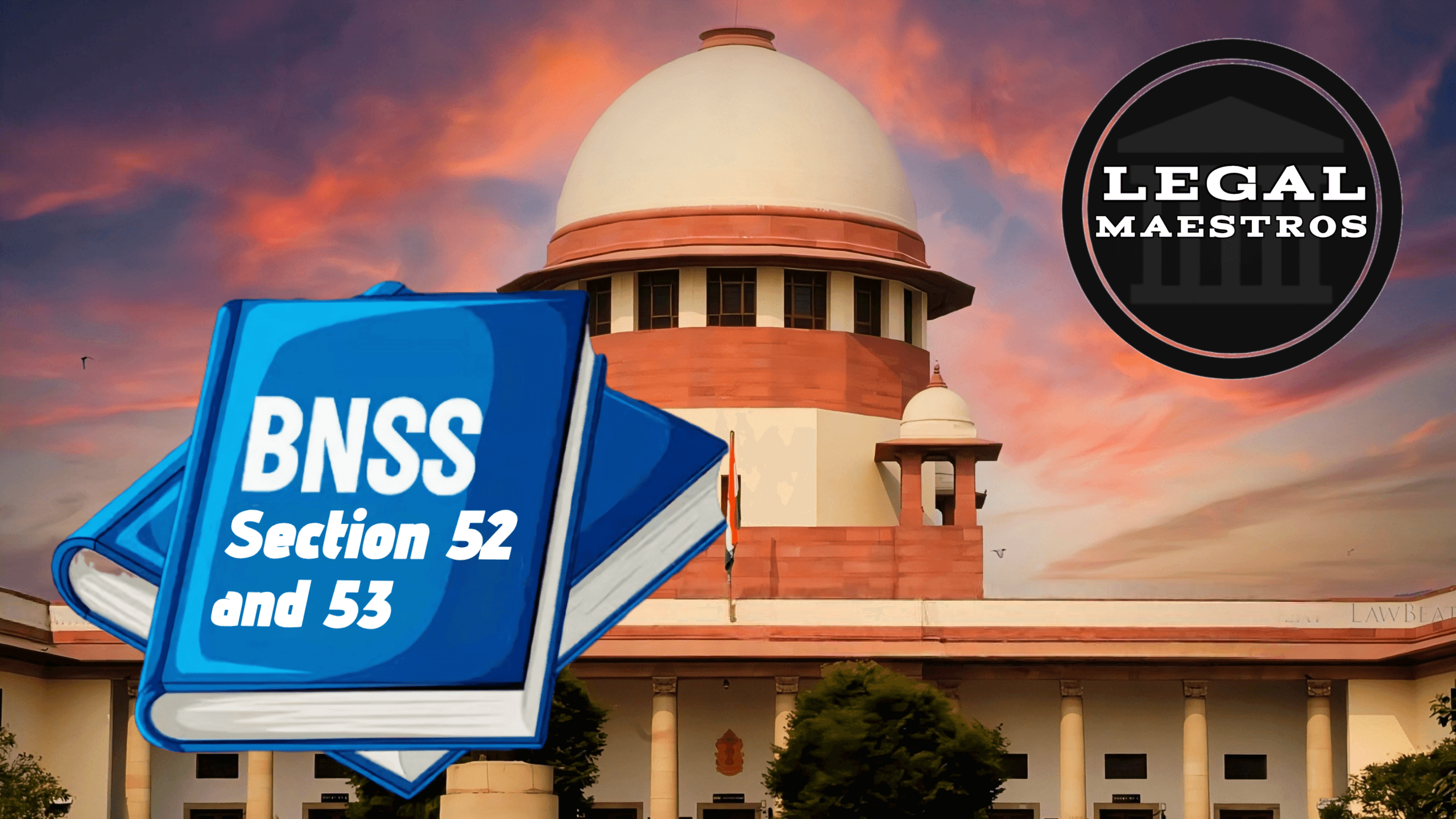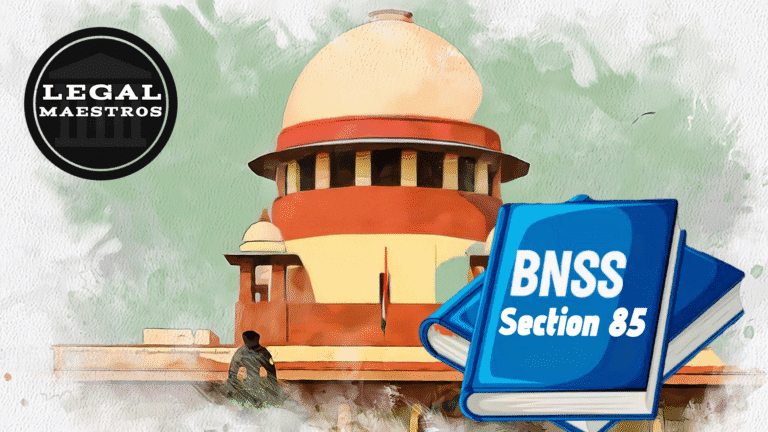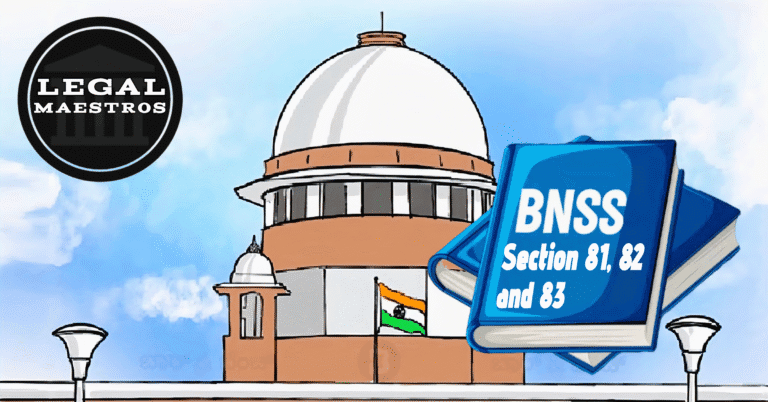
Section 52: Medical Examination of Person Accused of Rape
The medical examination of a person who has been arrested on an accusation of rape or attempted rape is addressed in Section 52 of the Bharatiya Nagarik Suraksha Sanhita, 2023. This section allows for the examination of the individual. This section provides an overview of the process that registered medical practitioners are required to follow, as well as the rights and obligations that are associated with conducting such an examination. With the help of this part, we will make certain that the appropriate medical evidence is acquired without any delay. This evidence may prove to be extremely important for the investigation and the court procedure.
The Authority of the Law to Conduct Medical Examinations
When an individual is arrested for the crime of committing rape or an attempt to commit rape, and there are reasonable grounds to suspect that inspecting the body of the accused can produce evidence relating to the crime, the law permits a medical examination to be carried out on the individual. During this examination, a registered medical practitioner who is employed in a hospital that is either run by the government or by a local authority is required to do the examination.
If, on the other hand, such a practitioner is not available within a radius of sixteen kilometers from the location where the offense was committed, then any other registered medical practitioner is able to carry out the examination. An inspection of this nature is carried out at the request of a law enforcement officer. If it is deemed necessary, the medical practitioner may also seek the assistance of another individual. This individual is afforded legal protection if they act in good faith and under the direction of the physician whenever they provide assistance. In the event that it is deemed essential to carry out the test in an appropriate manner, the use of reasonable force during the examination is also permissible.
For any queries or to publish an article or post or advertisement on our platform, do call at +91 6377460764 or email us at contact@legalmaestros.com.
Responsibilities of the Clinician or Physician
The registered medical practitioner is required to conduct an examination of the accused without delay in accordance with the legislation. Additionally, the examination report is required to include particular details that are mandated by the law. Details such as these are:
Full name and address of the person who is being accused.
The identity of the individual who took the accused person to the medical facility or examination center, including their name and address.
For any queries or to publish an article or post or advertisement on our platform, do call at +91 6377460764 or email us at contact@legalmaestros.com.
The alleged or approximate age of the person who is being accused.
There are any signs of harm that can be seen on the body of the accused.
For the purpose of DNA profiling, a detailed description of any material that was collected from the body of the accused.
For any queries or to publish an article or post or advertisement on our platform, do call at +91 6377460764 or email us at contact@legalmaestros.com.
Every other significant piece of information that was discovered during the examination.
Explanations for the Conclusions
Moreover, the medical practitioner is obligated to articulately explain the rationale behind each and every judgment that is taken in the report. In this way, transparency is maintained, and the court is better able to comprehend the connection between the medical findings and the alleged offense. In the event that the physician determines that a mark on the accused’s body is a bite mark, for instance, the report is required to provide an explanation as to why the doctor arrived at that judgment. This explanation could be based on the shape, size, or depth of the damage.
The Time of the Examination for Recording
Another essential aspect of Section 52 is the necessity to make a note of the precise time at which the examination begins and concludes. In order to guarantee that the timing of the medical treatment is precisely recorded, this is of the utmost importance. For instance, if an accused person is examined at five o’clock in the afternoon and the process is finished at six o’clock in the evening, the report needs to include both times.
For any queries or to publish an article or post or advertisement on our platform, do call at +91 6377460764 or email us at contact@legalmaestros.com.
Providing the Report to Others
When the report is finished being made, the medical practitioner is obligated to provide it to the officer who is conducting the investigation as soon as possible. It is then the responsibility of the law enforcement officer to incorporate this report into the collection of papers that will be presented to the Magistrate in accordance with Section 193 as a component of the evidence that pertains to the case.
Exemplification of the 52nd Section
Imagine for a moment that Ramesh is taken into custody on the suspicion that he attempted to rape a woman in a rural community. After being taken by the police to a neighboring government hospital, he is examined by the physician who is on duty at the facility. In the course of the examination, the physician discovers scratch marks on Ramesh’s hands and takes skin particles for the purpose of DNA analysis and examination. Following the preparation of a report that includes Ramesh’s age, the injuries, and the DNA samples that were collected, the physician sends the report to the authorities. The official evidence that is presented to the court includes this report as one of its components.
Section 53: Medical Examination of Arrested Person
In accordance with the Bharatiya Nagarik Suraksha Sanhita, 2023, Section 53 applies to all individuals who have been arrested, not simply those who are accused of committing rape. According to this provision, every individual who is arrested is required to have a medical examination. The primary purpose of this examination is to identify any injuries and to document the individual’s physical state at the time of arrest.
For any queries or to publish an article or post or advertisement on our platform, do call at +91 6377460764 or email us at contact@legalmaestros.com.
Evaluation of the Patient’s Health Following the Arrest
As soon as a person is taken into custody, they are required to undergo a medical examination by a medical officer who is employed by either the Central Government or the State Government. An examination can be carried out by a registered medical practitioner in the event that a government medical officer is unavailable to do the examination.
It is imperative that this test be carried out as quickly as possible once the arrest has been made. Establishing the physical condition of the person who was arrested is essential for both legal and medical records, and this helps establish that condition.
An Investigation into the Female Accused
Women who have been accused are afforded further protection under the law. In the event that the individual who was arrested is a female, the examination must be carried out by a certified female medical officer. A female registered medical practitioner is required to carry out the examination in the event that a female medical officer is not present to perform the examination. This ensures that the female accused is treated with dignity and that her privacy is protected.
For any queries or to publish an article or post or advertisement on our platform, do call at +91 6377460764 or email us at contact@legalmaestros.com.
Furthermore, the female medical practitioner have the authority to perform many examinations if she is of the opinion that carrying out multiple examinations is required. In the event that new injuries manifest themselves at a later time or if additional clarity is required, she is able to re-examine the individual.
Medical Report Preparation and Preparation
A written record is required to be prepared by the medical officer or practitioner who is conducting the examination with the patient. According to this report, any injuries or signs of violence that were found on the body of the person who was arrested should be mentioned. In addition to that, the report needs to give an estimation of the time at which those injuries could have been caused.
For instance, if the individual who was arrested has a bruise that appears to have developed within the past two hours, the doctor should describe that in addition to the nature of the injury and the location of the injury. It is essential to ascertain whether the damage occurred prior to or after to the arrest, as this information can be of critical importance in the course of legal proceedings.
For any queries or to publish an article or post or advertisement on our platform, do call at +91 6377460764 or email us at contact@legalmaestros.com.
The Right to Obtain a Copies of the Report
One of the most significant rights that is guaranteed by Section 53 is that the individual who has been arrested is entitled to receive a copy of the report of the medical examination. It is possible for the individual to designate a person to receive the report, such as a member of their family or a legal representative, if they so desire. This contributes to the maintenance of transparency and safeguards the rights of the individual who has been arrested. In addition, it prohibits the accused from misusing or altering medical evidence by providing them with a copy of the evidence in parallel.
The illustration of the 53rd section
Let us have a look at one more illustration. Imagine that Meena is taken into custody for theft. A female medical officer from a government hospital examines her as soon as she is brought into prison. This takes place in a government hospital. It is observed by the physician that she has a few tiny bruises on her arms as she is being examined. Meena asserts that the injuries were sustained during the process of being arrested. In the report, the physician makes a record of the injuries, provides an estimate of the time at which they occurred, and makes a note of any observations. Following that, Meena’s sister, whom Meena had chosen to be the recipient of the report, is given a copy of it. It is possible that this report will be used as evidence in the future to investigate whether or not any force was used during the arrest proceedings.




![Research Assistantship @ Sahibnoor Singh Sindhu, [Remote; Stipend of Rs. 7.5k; Dec 2025 & Jan 2026]: Apply by Nov 14, 2025!](https://legalmaestros.com/wp-content/uploads/2025/11/Gemini_Generated_Image_s0k4u6s0k4u6s0k4-768x707.png)
![Karanjawala & Co Hiring Freshers for Legal Counsel [Immediate Joining; Full Time Position in Delhi]: Apply Now!](https://legalmaestros.com/wp-content/uploads/2025/11/Gemini_Generated_Image_52f8mg52f8mg52f8-768x711.png)
![Part-Time Legal Associate / Legal Intern @ Juris at Work [Remote]: Apply Now!](https://legalmaestros.com/wp-content/uploads/2025/11/ChatGPT-Image-Nov-12-2025-08_08_41-PM-768x768.png)
![JOB POST: Legal Content Manager at Lawctopus [3-7 Years PQE; Salary Upto Rs. 70k; Remote]: Rolling Applications!](https://legalmaestros.com/wp-content/uploads/2025/11/ChatGPT-Image-Nov-12-2025-08_01_56-PM-768x768.png)
1 thought on “Sections 52 & 53 – Bharatiya Nagarik Suraksha Sanhita, 2023: Medical Examination of Accused and Arrested Persons”